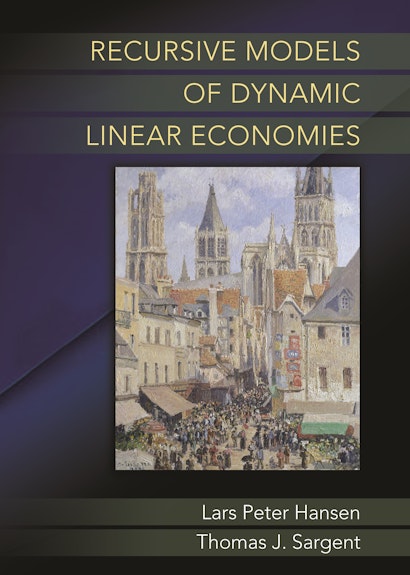A common set of mathematical tools underlies dynamic optimization, dynamic estimation, and filtering. In Recursive Models of Dynamic Linear Economies, Lars Peter Hansen and Thomas Sargent use these tools to create a class of econometrically tractable models of prices and quantities. They present examples from microeconomics, macroeconomics, and asset pricing. The models are cast in terms of a representative consumer. While Hansen and Sargent demonstrate the analytical benefits acquired when an analysis with a representative consumer is possible, they also characterize the restrictiveness of assumptions under which a representative household justifies a purely aggregative analysis.
Hansen and Sargent unite economic theory with a workable econometrics while going beyond and beneath demand and supply curves for dynamic economies. They construct and apply competitive equilibria for a class of linear-quadratic-Gaussian dynamic economies with complete markets. Their book, based on the 2012 Gorman lectures, stresses heterogeneity, aggregation, and how a common structure unites what superficially appear to be diverse applications. An appendix describes MATLAB programs that apply to the book’s calculations.
Awards and Recognition
- Lars Peter Hansen, Co-Winner of the 2013 Nobel Prize in Economics
- Thomas J. Sargent, Winner of the 2011 Nobel Prize in Economics
Lars Peter Hansen is the David Rockefeller Distinguished Service Professor at the University of Chicago, where he is also the research director of the Becker Friedman Institute. Thomas J. Sargent is professor of economics at New York University and a senior fellow at the Hoover Institution at Stanford University. His books include Rational Expectations and Inflation and The Conquest of American Inflation (both Princeton). Hansen and Sargent are the coauthors of Robustness (Princeton). Sargent was awarded the Nobel Prize in economics in 2011 and Hansen received it in 2013.
"This book is chock full of results that will be useful to all interested in dynamic linear models, including material that will be novel to even the experienced macroeconomist. Buy it, read it, use it."—Kenneth D. West, Journal of Economic Literature
"This is the ideal book for those who want to study, understand, and work with linear-quadratic dynamic economies. Providing a thorough, authoritative, yet accessible treatment, it contains a superb analysis of the connections between various linear-quadratic dynamic programming problems, the general equilibrium properties of these economies, the type of aggregation applicable to them, and the time-series implications for quantities and prices. A great book by two giants of the field."—Fernando Alvarez, University of Chicago
"In this tour-de-force of modern macroeconomics, Hansen and Sargent have written the definitive text on linear-quadratic economies that illustrate the connection between preferences and technology and the appropriate time-series representation. This gem of a book not only provides a thorough review of mathematical methods and related computational issues, but also includes cutting-edge economic models. It will be the required reference for anybody who works in modern dynamic macroeconomic problems."—Rodolfo E. Manuelli, Washington University in St. Louis
"Modern macroeconomics relies on dynamic equilibrium modeling and the statistical analysis of time-series data. This superb book teaches both techniques hands-on. It guides readers towards mastering a library of computer programs that work for many practical problems, a library that readers will then build on in their own macroeconomic research."—Martin Schneider, Stanford University
"It is nearly impossible to think of a better set of coauthors for this subject. I read their superior book with great pleasure and learned much from it."—Jesus Fernandez-Villaverde, University of Pennsylvania
"Drawing strong connections between mathematics and economic intuition, this rigorous and insightful book contains an extremely broad set of applications, treated from the same consistent framework. The exposition of the benchmark model is outstanding and unique."—John Stachurski, Australian National University



